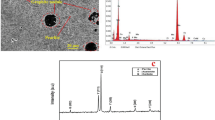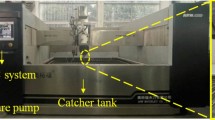Abstract
A computer numeric control (CNC) router equipped with ultra-high pressure abrasive water jets was used to investigate the effects of wood species (density), pressure of water jet, feeding speed of wood samples and screen mesh grade of abrasives on the quality of hardwood floors. Owing to the high operational cost during the mill trial, a statistical methodology named orthogonal array testing (OAT), which reduced the number of factor combinations and exhibited maximum coverage with a minimum number of test scenarios, was employed in this study. Through both industrial-scale trials and statistical analysis, it was concluded that the wood density of 0.70 g/cm3, the water pressure of 280 MPa, the feeding speed of 80 mm/min and the abrasive size of 100 screen mesh grades yielded the optimum combination for achieving the best quality during abrasive water jet machining on hardwood floors. Among the four factors, the water jet pressure had the most important impact on the surface quality, followed by the abrasive size, wood density and feeding speed. In addition, the results also demonstrated that OAT is a cost-effective method to be used for achieving optimal machining parameters in the mill environment.
Zusammenfassung
Unter Verwendung einer CNC-gesteuerten Konturfräsmaschine mit Ultrahochdruck-Wasserstrahlen wurde der Einfluss von Holzart (Dichte), Wasserstrahldruck, Vorschubgeschwindigkeit der Holzproben und Korngröße der zugegebenen Schleifmittel auf die Qualität von Hartholzfußböden untersucht. Wegen der hohen Betriebskosten beim Industrieversuch wurde ein statistisches Verfahren namens Orthogonal Array Testing (OAT) angewandt. Bei diesem Verfahren lässt sich die Anzahl der Faktorkombinationen reduzieren und eine maximale Abdeckung bei minimaler Anzahl an Versuchen erreichen. Aus den Industrieversuchen und statistischen Analysen ergab sich, dass eine Holzdichte von 0,70 g/cm3, ein Wasserdruck von 280 MPa, eine Vorschubgeschwindigkeit von 80 mm/min und eine Korngröße von 100 die optimale Faktorkombination ist, um die beste Qualität beim Wasserstrahlschneiden von Hartholzfußböden zu erhalten. Dabei hatte der Wasserstrahldruck den größten Einfluss auf die Schnittqualität, gefolgt von Korngröße, Holzdichte und Vorschubgeschwindigkeit. Daneben zeigten die Ergebnisse, dass OAT ein kostengünstiges Verfahren ist, mit dem optimale Bearbeitungsparameter bei der industriellen Fertigung erzielt werden können.



Similar content being viewed by others

References
Bryan BL (1963) High energy jets as a new concept in wood machining. For Prod J 13(8):305–312
Chen FL, Siores E, Patel K (2002) Improving the cut surface qualities using different controlled nozzle oscillation techniques. Int J Mach Tools Manuf 42:717–722
Franz NC (1970a) High-energy liquid jet slitting of corrugated board. TAPPI 53(6):1111–1114
Franz NC (1970b) High velocity liquid jet. US Patent No 3,524,367
Franz NC (1970c) Method of high velocity liquid jet cutting of soft materials. US Patent No 3,532,014
Franz NC (1972) Fluid additives for improving high velocity jet cutting. In: Proc first international symposium on jet cutting technology. BHRA Fluid Engineering, Cranfield, pp 93–104. Paper A7
Franz NC (1974) The influence of stand-off distance on cutting with high velocity fluid jets. In: Proc second international symposium on jet cutting technology. BHRA Fluid Engineering, Cranfield, pp 37–46. Paper B3
Harris HD (1970) Cutting with high speed water jets. Manuf Dev Nat Res Counc Can 2(1):1–2
He JL, Du DX, Wang Z, Pu WJ, Fang K (2009) Study on orthogonal experiments with the technology of numerical control extra-high tension water-jet sawing the floral formula solid wood flooring. In: Proceedings of international wood machining seminar. Nanjing, China, pp 198–203
Kinga G (2002) Abrasive water jet cutting: a possibility for minimizing waste in the sawmill industry. Forst Holz 57(7):215–216
Lee HW (2004) Abrasive-assisted high energy water-jet machining characteristics of solid wood. J Korean Wood Sci Technol 32(3):1–7
Pascuzzi S, Pellerano A (1998) Using a water jet for cutting wood inlay for parquet production. Riv Ing Agrar 29(4):209–218
Szymani R (1972) A study of corrugated board cutting by high velocity liquid jet. For Prod J 22(8):17–25
Szymani R, Dickinson FE (1975) Recent developments in wood machining processes: novel cutting techniques. Wood Sci Technol 9(2):113–128
Taguchi G (1987) System of experimental design, vols 1 & 2. UN IPUB/Krass International Publications, New York. Edited by Don Clausing
Wang J, Guo DM (2002) A predictive depth of penetration model for abrasive water jet cutting of polymer matrix composites. J Mater Process Technol 121:390–394
Author information
Authors and Affiliations
Corresponding author
Rights and permissions
About this article
Cite this article
Wang, Z. An investigation on water jet machining for hardwood floors. Eur. J. Wood Prod. 70, 55–59 (2012). https://doi.org/10.1007/s00107-010-0492-0
Received:
Published:
Issue Date:
DOI: https://doi.org/10.1007/s00107-010-0492-0



